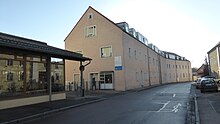New Ettmannsdorf Castle
The New Ettmannsdorf Palace is a former baroque palace in what is now the Ettmannsdorf district of the Upper Palatinate town of Schwandorf (Ettmannsdorfer Straße 131).
history
The history of the castle is said to go back to the 13th century. In 1292 the Paulsdorfer acquire real estate in Ettmannsdorf. A Chunrad Paulsdorfer is said to have built a manor here in 1296. This is presumed to be in the area of the New Palace (the later stables and agricultural buildings). In the ducal land register of 1326 an Otto, servant of Weigel von Trausnitz, is mentioned, who pays the Vogtzins . In 1327, Herrmann Marschall von Naabeck held the courtyard next to the church . In addition, the Parsbergers owned the mill in Ettmannsdorf. In 1347 Conrad Paulsdorfer von Haselbach and his wife Osanna are the local owners; this is followed by their son Niklas Paulsdorfer. In 1412 Heimeram Nothracht von Wernberg is the owner of Ettmannsdorf, who got the property through marriage through his wife Praxedis Paulsdorfer. In 1419 Conrad VII. Paulsdorfer, a nephew of Praxedis, and in 1422 Wilhelm Paulsdorfer were wealthy here. In 1423, during a visit by Count Palatine Johann in Schwandorf, the truce of Ettmannsdorf was staked out and since then Ettmannsdorf has been a court mark (see also Ettmannsdorf Old Castle ).
From 1650 the Rußwurms are the lords of Ettmannsdorf . The first of this family is Hanns Christoph Rußwurm. He was succeeded by Peter Wenzel von Rußwurm, Truchseß and carer from Hemau . He was married to Rosina Sophia, Countess von Kreith. In 1700 he built the New Palace in Ettmannsdorf, which later became the monastery "for the good shepherd". He himself died in 1705. Wolf Philipp von Rußwurm performed the compulsory Landsassenpflicht on October 18, 1706 († 1727). He was followed by his son Veith Ludwig von Rußwurm. He was forester in Painten , nurse to Hemau and captain of the bodyguard. He died childless in Mannheim in 1762 . This was also the end of the Rußwurm family on Haselbach and Ettmannsdorf.
The Hofmark then came to Karoline Franziska Dorothea von Parkstein through purchase . This was a daughter of the elector Karl Theodor of Palatinate-Bavaria and Françoise Després-Verneuil (actually baker's daughter Franciska Huber from Mannheim), born out of wedlock. Karoline von Parkstein owned the Ettmannsdorf and Haselbach court brands until 1769. On June 27, 1777, Baron Max Karl von Spiering († March 15, 1787) bought the two court brands on Fronberg . For the underage son Carl Theodor von Spiering, the lawyer Miltner gave up the compulsory Landsassenpflicht on December 19, 1778, Carl Thodor could only take over the Hofmark from 1804 († June 21, 1829 in Regensburg). He was the last male descendant of the von Spiering family. He is known to have been very afraid of apparent death; therefore he was buried in a crypt with glass windows and in a coffin that could be opened from the inside in the Fronberg Castle Park. In addition, a lighter to turn on the light and a few bottles of wine had to be provided. Only after some time was the crypt walled up. Carl Theodor left three daughters: (1) Ida, married to the Württemberg Chamberlain, Count Friedrich von Dillen; (2) Agnes, married to the royal Bavarian treasurer, Count Carl von Butler-Clonebough and Caroline, who took over the property in Fronberg, Ettmannsdorf and Haselbach.
Caroline von Spiering married the royal chamberlain Karl Theodor Count von Holnstein zu Schwarzenfeld in 1831 (coming from a bastard line of the Wittelsbach family). The married Caroline von Holnstein managed her property herself. Count Maximilian von Holstein, a close confidante of King Ludwig II, came from the marriage . The marriage was already divorced in 1836 "from bed and table", but it was not until 1857 that she was allowed to marry her lover Wilhelm Freiherr von Künsberg . In 1859 ownership passed to him. With him, Caroline had four illegitimate children who were legitimized in 1859 as "Künsberg, Freiherrn und Freiinnen von Fronberg".
In 1861 a baron von Ziegler bought the Ettmannsdorf manor, but sold it to the barons of Podewils in 1866 . From 1866 to 1992 it was owned by the Order of the Sisters of the Good Shepherd .
New Ettmannsdorf Castle today
The New Palace (acquired by him in 1777) has not been inhabited since Baron Max Karl von Spiering. I.e. the castle was also no longer maintained and the residents of Ettmannsdorf looted the vacant building. After the Austro-French War of 1796, wounded Austrians were cared for in the castle, which had been converted into a hospital .
The Order of the Sisters of the Good Shepherd established a monastery in the dilapidated building from 1866. The order initially operated an institution for orphaned and neglected children. The Catholic youth welfare of the Diocese of Regensburg opened a vocational school in the new castle in 1981 to promote individual learning and in 1992 took over the entire facility. In the following years, workshops for wood, metal and paint as well as a garden center with greenhouses, a laundry, residential groups for male youths and leisure rooms with a cafeteria, pottery, barbecue area and a gym were created.
There are still vaulted walkways in the entrance area, and there is also a monastery wall surrounding the property and a large garden landscape in the rear area.
literature
- Weingärtner, Hans: Ettmannsdorf 1010 - 2010. A thousand years of village history must not be forgotten. Self-published: Burglenfeld, 2010.
Web links
- The coats of arms of the hammer owners, lords of the castle and owners of Hofmarks zu Ettmannsdorf
- Ettmannsdorf on aerial photo Laumer
Individual evidence
Coordinates: 49 ° 19 ′ 42.7 ″ N , 12 ° 5 ′ 0 ″ E






